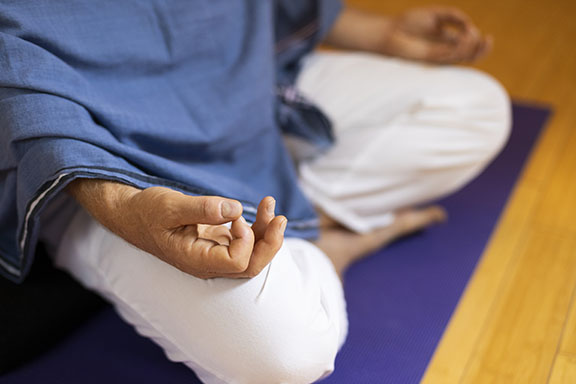 You may, at some point, feel inspired to make a transition from being a Hatha Yoga class attendee to being a more involved yogi. This means developing a personal practice, where you make the connection to your own inner peace on a daily basis. In fact, this connection with the peace within you can become the most significant aspect in your day-to-day life. Having made the connection, you continue throughout the day’s activities full of energy and radiating peace.
You may, at some point, feel inspired to make a transition from being a Hatha Yoga class attendee to being a more involved yogi. This means developing a personal practice, where you make the connection to your own inner peace on a daily basis. In fact, this connection with the peace within you can become the most significant aspect in your day-to-day life. Having made the connection, you continue throughout the day’s activities full of energy and radiating peace.
The most essential aspect of developing a personal practice is regularity. This may sound mundane and obvious, but the reality is that life itself often gets in the way of a regular Yoga practice. We find ourselves putting our Yoga practice on the back burner while taking care of all the other important emergencies of life, and we find ourselves becoming stressed out and needing the very practice for which we don’t have time.
First, take back the time needed for practice. This has to be done by analyzing one’s schedule and realistically finding a time for Yoga. Probably this will mean either getting up earlier or staying up later. Pick one, as you’ll find you can’t do both. It is best to have a consistent time of day.
After you have the time, you need a place. Create a place, a sacred space where you are comfortable and free to practice without interruption. This is your time and place. It should be clean, well ventilated and have whatever is necessary for you to do your practice with no distraction. Turn off the phone and TV, avoid chaos and go within. Gurudev (Swami Satchidananda) says that preparation is 90 percent of the practice. If everything is ready, it will be easy to get started and continue.
Here’s a suggestion of what to practice: Take the core sequence of Integral Yoga Hatha and make it your own. Depending on the time available to you, create a practice of asanas, deep relaxation and pranayama, leading into meditation. If the time is limited, reduce the amount of time in asanas so that the pranayama and meditation time is never lost.
Over time, the personal practice of Hatha Yoga will grow and change according to your needs. Although the basic core sequence remains the foundation of the practice, optional poses may be added and varied depending on the goal and need. For example: If you are concerned with your weight, you may want to do more repetitions of surya namaskar and more standing poses. If you want to be able to sit comfortably in lotus pose or some other meditation pose, you may need to do more hip opening asanas and poses that protect the knee. If you want to build upper body strength, you may find more arm balances and shoulder stretches very helpful. If you have digestive problems, you may concentrate on more like the half spinal twist and poses like locust, head to knee pose and the stomach lift, which all massage the abdomen.
At times, you might see a pose that gives your practice a good push and new challenge and work with that for some time. The specialty areas will change from time to time, but the foundation remains the same. The simple and balanced approach given by Sri Gurudev leads one to having physical health, strength, balance and flexibility and a peaceful mind.
Take some time at the end of every day to reflect on your practice and daily activities. Observe the transformative effects that the Yoga practice is having in the body and mind. It can be a great help to maintain a spiritual diary or journal.
Adopting a pure, sattvic, yogic diet will greatly enhance the benefits of the Yoga practice. Sri Gurudev always recommended a vegetarian diet for Yoga practitioners.
These simple practices, incorporated into daily life will lead one to a life of health and happiness. In the words of Sri Gurudev: “Health is your birthright, but not disease; strength your heritage, but not weakness; courage, but not fear; bliss, but not sorrow; peace, but not restlessness; knowledge but not ignorance. May you attain this birthright, this divine heritage to shine as fully developed yogis, radiating joy, peace and knowledge everywhere. OM Shanti, Shanti, Shanti.”

 About the Author
About the Author
Satya Greenstone has been a student of Sri Swami Satchidananda for almost four decades. In 1978, she and her husband started the Yogaville Vidyalayam and, for 17 years, taught at this elementary school for the children of the ashram’s community. Since 1999, she has been a primary teacher for the Basic Yoga Teacher Training Program. Satya has been practicing and teaching Integral Yoga for many years, gently adapting the Yoga practices to any individual’s needs and always finding a way to encourage and inspire her students.


